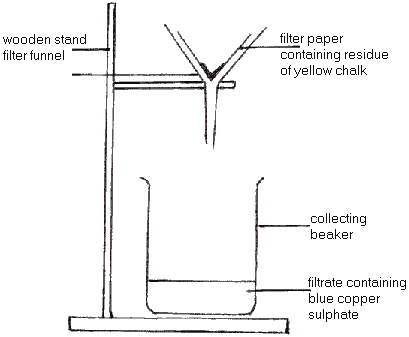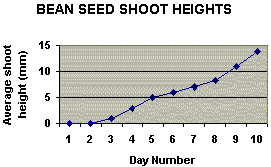
- REMEMBER TO PUT YOUR NAME AND DATE ON THE EXPERIMENT.
- REPORTS SHOULD BE LEGIBLE AND CLEAR.
- REPORTS SHOULD BE HANDED IN WITHIN ONE WEEK AFTER THE EXPERIMENT IS PERFORMED.
- NAME: Your name
- TITLE: The name of the experiment
- DATE: The date that the experiment was performed
- AIM: A brief statement of the experiment's purpose, as stated in the textbook / laboratory manual
- MATERIALS: A list of the materials used in the experiment
- METHOD: A brief description of the method used, set out in numbered steps and including a diagram where needed
- RESULTS: All results of the experiment should be recorded. Usually data is presented in the form of tables and graphs, particularly if numerical calculations are used. Units of measurement (e.g. cm, mm, g, kg) should always be written.
- CONCLUSIONS: This is the most important part of every scientific report and allows you to make a personal contribution to the experiment. The following should be discussed - agreement between your results and theory, chief sources of experimental error, applications of the results obtained or the techniques used, relevance of the experimental data.
- QUESTIONS: A set of questions appear at the end of each experiment in the textbook / laboratory manual. These should be answered as precisely as possible.
EXAMPLE 1 OF YEARS 8 - 10 SCIENCE LABORATORY REPORT
- Name: Robert Kelly
- Date: 4th February, 2001
- Title: Filtration
- Aim: To separate a mixture of a soluble substance (i.e. blue copper sulphate powder) and an insoluble substance (i.e. yellow chalk powder)
- Materials: 1 filter funnel 1 stirring rod
- 1 piece of filter paper blue copper sulphate powder
- 1 wooden stand yellow chalk powder
- 2 beakers distilled water
- 2 spatulas safety goggles
- Method:
- Add 5 grams of blue copper sulphate powder and 5 grams of yellow chalk powder to a beaker half-filled with distilled water.
- Stir with the stirring rod until the copper sulphate dissolves.
- Fold the filter paper into quarters and place into the filter funnel. Wet the filter paper with distilled water to hold it in place in the funnel.
- Set up the apparatus as shown in the diagram.
- Pour the mixture into the filter paper a little at a time. Do not overfill.
- Continue to pour the mixture until the whole of the mixture has been filtered.
- Observe and record the contents of the residue in the filter paper and the filtrate in the collecting beaker.

Results:
- The residue in the filter paper contains the yellow chalk powder.
- The filtrate in the collecting beaker contains the blue copper sulphate powder dissolved in water.
Conclusions:
Filtration separates soluble and insoluble substances because the dissolved particles of copper sulphate are so small that they pass through fine holes in the filter paper. Insoluble particles are too large to pass through the filter paper.
EXAMPLE 2 OF YEARS 8 - 10 SCIENCE LABORATORY REPORT
- Name: Jasmin Huang
- Date: 23rd February, 2001
- Title: Germination and Development of Bean Seeds
- Aim: To observe, measure and record the germination and development of bean seeds over a period of 2 weeks
- Materials: 4 bean seeds
- 4 beakers
- cotton wool
- 1 ruler
- Method:
- Place each of the 4 bean seeds in a different orientation on moist cotton wool in each of the 4 beakers.
- Place all 4 beakers in a well-lit position where each beaker receives the same amount of light and warmth.
- Ensure that the cotton wool is kept moist, by adding the same amount of water to each beaker at the same time each day.
- When the seeds germinate, observe the direction and growth of the shoots and the roots. Record the data.
- At the same each day, measure the heights of the shoots and record the data in a table and a graph.
- Continue the experiment for 2 weeks.
Results:
| Shoot Growth |
Root Growth | Shoot Height (mm) on Day … |
||||||||||
1 |
2 | 3 | 4 | 5 | 6 | 7 | 8 | 9 | 10 | |||
| Bean Plant 1 | up |
down | 0 | 0 | 0 | 2 | 4 | 5 | 6 | 8 | 11 | 15 |
| Bean Plant 2 | up |
down | 0 | 0 | 1 | 3 | 5 | 6 | 8 | 9 | 12 | 15 |
| Bean Plant 3 | up |
down | 0 | 0 | 2 | 3 | 5 | 7 | 7 | 8 | 9 | 13 |
| Bean Plant 4 | up |
down | 0 | 0 | 1 | 4 | 6 | 6 | 7 | 7.5 | 12 | 14 |
| Average | 0 | 0 | 1 | 3 | 5 | 6 | 7 | 8.1 | 11 | 13.8 | ||

Conclusions:
- Bean seeds require water to germinate.
- Gravity affects bean seed growth. The shoot grow upwards, and the roots grow downwards.
- Bean seeds germinate and grow at different rates.